The B2B Middleware Market is estimated to be valued at USD 4.0 billion in 2025 and is projected to reach USD 7.5 billion by 2035, registering a compound annual growth rate (CAGR) of 6.4% over the forecast period.
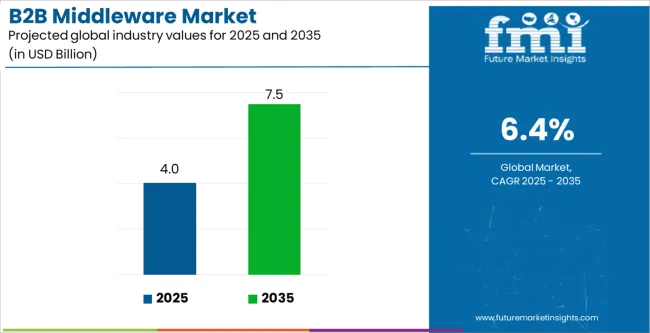
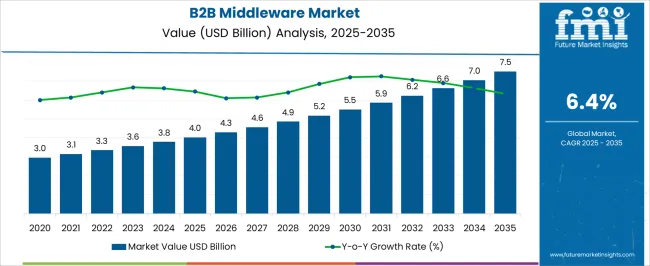
| Metric | Value |
|---|---|
| B2B Middleware Market Estimated Value in (2025 E) | USD 4.0 billion |
| B2B Middleware Market Forecast Value in (2035 F) | USD 7.5 billion |
| Forecast CAGR (2025 to 2035) | 6.4% |
The B2B Middleware market is experiencing steady growth, driven by increasing demand for seamless integration between disparate enterprise applications, cloud services, and partner systems. Organizations are focusing on achieving real-time data exchange, process automation, and operational efficiency, which has elevated the adoption of middleware solutions across industries. Advances in API management, integration platforms, and cloud-enabled middleware are enhancing connectivity and interoperability while reducing IT complexity.
The market is further supported by the growing need for secure data sharing, compliance with regulatory requirements, and scalability in response to digital transformation initiatives. Organizations are leveraging middleware to facilitate business-to-business communications, streamline supply chain operations, and optimize transaction workflows.
The rising adoption of hybrid IT architectures, coupled with the need for flexible, cost-efficient integration platforms, is creating growth opportunities As enterprises continue to embrace digital ecosystems and multi-cloud environments, the B2B Middleware market is expected to sustain long-term expansion, driven by technological innovation, operational efficiency, and enhanced enterprise connectivity.
The b2b middleware market is segmented by organization size, verticals, and geographic regions. By organization size, b2b middleware market is divided into SMB (Small & Medium Businesses) and Large Enterprises. In terms of verticals, b2b middleware market is classified into Banking Sector, Financial Service, Insurance (BFSI), Healthcare Sector, Government Enterprises, Telecom, Retail Enterprises, Energy And Utilities, Travel & Hospitality, Education, Manufacturing, Aerospace, and Defense & Others. Regionally, the b2b middleware industry is classified into North America, Latin America, Western Europe, Eastern Europe, Balkan & Baltic Countries, Russia & Belarus, Central Asia, East Asia, South Asia & Pacific, and the Middle East & Africa.
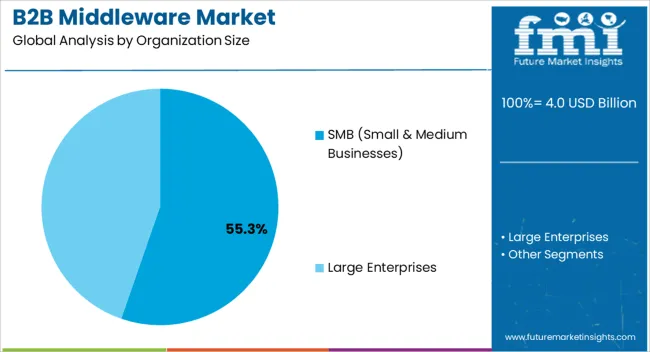
The SMB (Small & Medium Businesses) organization size segment is projected to hold 55.3% of the B2B Middleware market revenue in 2025, making it the leading category. Growth in this segment is being driven by the increasing need for scalable and cost-effective integration solutions that allow SMBs to compete effectively with larger enterprises. Middleware adoption enables small and medium businesses to automate workflows, integrate applications, and manage data efficiently without investing heavily in complex IT infrastructure.
Cloud-based and API-driven middleware platforms provide flexibility and ease of deployment, which is particularly appealing to SMBs with limited technical resources. The ability to connect with partners, suppliers, and customers in real-time improves operational efficiency and responsiveness.
SMBs are increasingly prioritizing digital transformation to enhance competitiveness, streamline processes, and support business growth As a result, the demand for agile, low-cost, and scalable middleware solutions is expected to reinforce the market leadership of the SMB segment, driven by ongoing technological advancements and business integration needs.
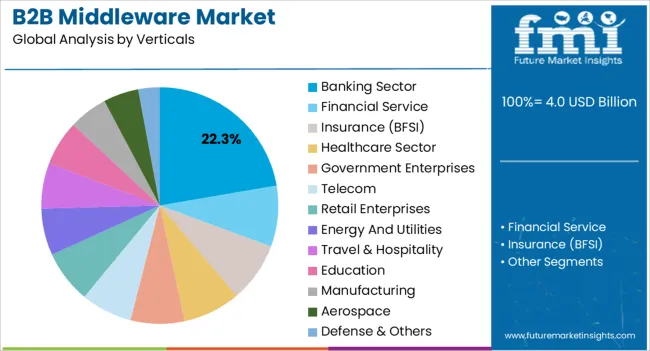
The banking sector verticals segment is anticipated to account for 22.3% of the market revenue in 2025, making it the leading vertical. Growth in this segment is being driven by the critical need for secure, real-time, and compliant integration of banking applications, payment gateways, and financial networks. Middleware enables seamless data exchange between core banking systems, digital channels, and partner ecosystems, improving operational efficiency and customer experience.
Regulatory compliance and data privacy requirements, such as KYC, AML, and GDPR, further reinforce the adoption of robust middleware solutions in banking. Financial institutions are leveraging middleware to streamline transaction processing, support omnichannel banking, and enable faster deployment of new services.
The ability to integrate legacy systems with modern applications without disrupting operations is another key factor driving adoption As digital banking and fintech partnerships expand, the banking sector vertical is expected to remain a primary growth driver for B2B Middleware solutions, supported by advancements in secure, scalable, and cloud-enabled integration technologies.
B2B middleware is a Business to Business software that resides above the network and below the business-aware application software. In simple words B2B, is an e-commerce gateway, which is responsible for the transaction of goods & services between the businesses or it can be between the business & individual customer or between the enterprises and trading partners. E-commerce is the buying and selling of goods, products or services through the internet.
With the help of B2B concept, an enterprise can expand its business over the internet to different trading partners without any regional restrictions. Which requires a trustworthy business process platform, transparency and end to end tracking process and service governance & centralized security.
Middleware is the platform which is needed to make e-commerce more efficient. Middleware is a set of common business services which enable the business processes and end users to interact directly with each other across the network, for example: an end user can track his/her product himself with the help of software instead of contacting enterprise.
B2B middleware market is still an emerging market and having the fair growth chances in the forecasting period.
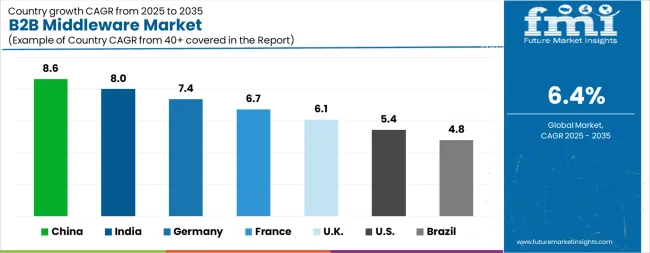
| Country | CAGR |
|---|---|
| China | 8.6% |
| India | 8.0% |
| Germany | 7.4% |
| France | 6.7% |
| UK | 6.1% |
| USA | 5.4% |
| Brazil | 4.8% |
The B2B Middleware Market is expected to register a CAGR of 6.4% during the forecast period, exhibiting varied country level momentum. China leads with the highest CAGR of 8.6%, followed by India at 8.0%. Developed markets such as Germany, France, and the UK continue to expand steadily, while the USA is likely to grow at consistent rates. Brazil posts the lowest CAGR at 4.8%, yet still underscores a broadly positive trajectory for the global B2B Middleware Market. In 2024, Germany held a dominant revenue in the Western Europe market and is expected to grow with a CAGR of 7.4%. The USA B2B Middleware Market is estimated to be valued at USD 1.4 billion in 2025 and is anticipated to reach a valuation of USD 2.3 billion by 2035. Sales are projected to rise at a CAGR of 5.4% over the forecast period between 2025 and 2035. While Japan and South Korea markets are estimated to be valued at USD 191.8 million and USD 121.1 million respectively in 2025.
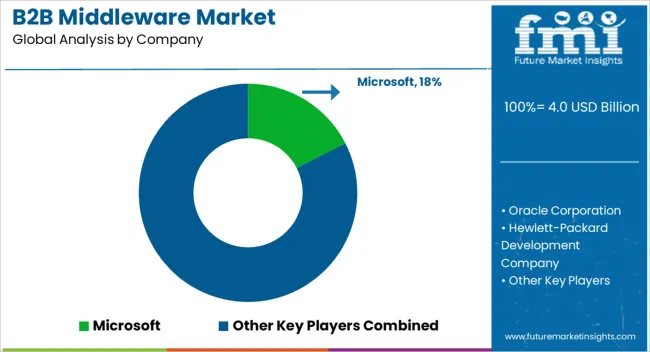
| Item | Value |
|---|---|
| Quantitative Units | USD 4.0 Billion |
| Organization Size | SMB (Small & Medium Businesses) and Large Enterprises |
| Verticals | Banking Sector, Financial Service, Insurance (BFSI), Healthcare Sector, Government Enterprises, Telecom, Retail Enterprises, Energy And Utilities, Travel & Hospitality, Education, Manufacturing, Aerospace, and Defense & Others |
| Regions Covered | North America, Europe, Asia-Pacific, Latin America, Middle East & Africa |
| Country Covered | United States, Canada, Germany, France, United Kingdom, China, Japan, India, Brazil, South Africa |
| Key Companies Profiled | Microsoft, Oracle Corporation, Hewlett-Packard Development Company, FUJITSU, Information Builders, LP, SAP SE, OpenText Corp., Unisys, Software AG, Unisys Global Technologies, and TIBCO Software Inc. |
The global B2B middleware market is estimated to be valued at USD 4.0 billion in 2025.
The market size for the B2B middleware market is projected to reach USD 7.5 billion by 2035.
The B2B middleware market is expected to grow at a 6.4% CAGR between 2025 and 2035.
The key product types in B2B middleware market are smb (small & medium businesses) and large enterprises.
In terms of verticals, banking sector segment to command 22.3% share in the B2B middleware market in 2025.






Our Research Products

The "Full Research Suite" delivers actionable market intel, deep dives on markets or technologies, so clients act faster, cut risk, and unlock growth.

The Leaderboard benchmarks and ranks top vendors, classifying them as Established Leaders, Leading Challengers, or Disruptors & Challengers.

Locates where complements amplify value and substitutes erode it, forecasting net impact by horizon

We deliver granular, decision-grade intel: market sizing, 5-year forecasts, pricing, adoption, usage, revenue, and operational KPIs—plus competitor tracking, regulation, and value chains—across 60 countries broadly.

Spot the shifts before they hit your P&L. We track inflection points, adoption curves, pricing moves, and ecosystem plays to show where demand is heading, why it is changing, and what to do next across high-growth markets and disruptive tech

Real-time reads of user behavior. We track shifting priorities, perceptions of today’s and next-gen services, and provider experience, then pace how fast tech moves from trial to adoption, blending buyer, consumer, and channel inputs with social signals (#WhySwitch, #UX).

Partner with our analyst team to build a custom report designed around your business priorities. From analysing market trends to assessing competitors or crafting bespoke datasets, we tailor insights to your needs.
Supplier Intelligence
Discovery & Profiling
Capacity & Footprint
Performance & Risk
Compliance & Governance
Commercial Readiness
Who Supplies Whom
Scorecards & Shortlists
Playbooks & Docs
Category Intelligence
Definition & Scope
Demand & Use Cases
Cost Drivers
Market Structure
Supply Chain Map
Trade & Policy
Operating Norms
Deliverables
Buyer Intelligence
Account Basics
Spend & Scope
Procurement Model
Vendor Requirements
Terms & Policies
Entry Strategy
Pain Points & Triggers
Outputs
Pricing Analysis
Benchmarks
Trends
Should-Cost
Indexation
Landed Cost
Commercial Terms
Deliverables
Brand Analysis
Positioning & Value Prop
Share & Presence
Customer Evidence
Go-to-Market
Digital & Reputation
Compliance & Trust
KPIs & Gaps
Outputs
Full Research Suite comprises of:
Market outlook & trends analysis
Interviews & case studies
Strategic recommendations
Vendor profiles & capabilities analysis
5-year forecasts
8 regions and 60+ country-level data splits
Market segment data splits
12 months of continuous data updates
DELIVERED AS:
PDF EXCEL ONLINE
B2B Services Review Platforms Market Size and Share Forecast Outlook 2025 to 2035
B2B Hygienic Paper Market Size and Share Forecast Outlook 2025 to 2035
B2B Travel Market Size and Share Forecast Outlook 2025 to 2035
B2B Sports Nutrition Market Analysis by Form, Application, Packaging, Distribution Channel and Region through 2035
B2B Telecommunication Market Analysis by Solution, End-User, Vertical, and Region from 2025 to 2035
B2B Payments Platform Market
Cloud API And Management Platforms And Middleware Market Size and Share Forecast Outlook 2025 to 2035

Thank you!
You will receive an email from our Business Development Manager. Please be sure to check your SPAM/JUNK folder too.
Chat With
MaRIA